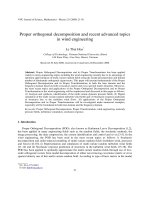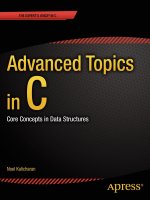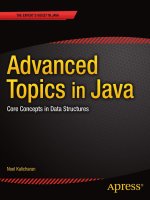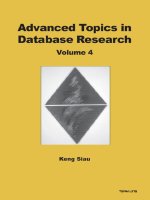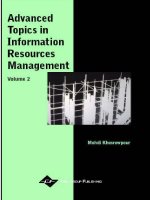Topics in advanced econometrics
Bạn đang xem bản rút gọn của tài liệu. Xem và tải ngay bản đầy đủ của tài liệu tại đây (12.72 MB, 424 trang )
Topics in Advanced Econometrics
Volume II
r
l",',
I
I
I
Phoebus J. Dhrymes
Topics in Advanced
Econometrics
Volume II
Linear and Nonlinear
Simultaneous Equations
Springer-Verlag
New York Berlin Heidelberg London Paris
Tokyo Hong Kong Barcelona Budapest
Phoebus J. Dhryrnes
Department of Economics
Columbia University
New York, NY 10027
USA
Library of Congress Cataloging-in-Publication Data
Dhrymes, Phoebus J.
Topics in advanced econometrics.
(v, 2: Linear and nonlinear simultaneous equations)
Includes bibliographical references
and index.
Contents: [II Probability foundations-v. 2. Linear
and nonlinear simultaneous equations.
I. Econometrics. 2. Probabilities. I. Title.
HB139.D49 1989
330' .01'5195
89-27330
ISBN 0-387-94156-8
Printed on acid-free paper.
© 1994Springer-Verlag New York, Inc.
All rights reserved. This work may not be translated or copied in whole or in part without the
written permission of the publisher (Springer-Verlag New York, Inc., 175 Fifth Avenue, New
York, NY 10010, USA), except for brief excerpts in connection with reviews or scholarly
analysis. Use in connection with any form of information storage and retrieval, electronic
adaptation, computer software, or by similar or dissimilar methodology now known or hereafter developed is forbidden.
The use of general descriptive names, trade names, trademarks, etc., in this publication, even
if the former are not especially identified, is not to be taken as a sign that such names, as
understood by the Trade Marks and Merchandise Marks Act, may accordingly be used freely
by anyone.
Production managed by Natalie Johnson; manufacturing supervised by Genieve Shaw.
Photocomposed copy produced using the author's LaTeX files.
Printed and bound by Braun-Brumfield, Inc., Ann Arbor, MI.
Printed in the United States of America.
987654321
ISBN 0-387-94156-8 Springer-Verlag New York Berlin Heidelberg
ISBN 3-540-94156-8 Springer-Verlag Berlin Heidelberg New York
To Ingram Olkin and Henri Theil, who stimulated
my early interest in econometrics
Preface
This book is intended for second year graduate students and professionals
who have an interest in linear and nonlinear simultaneous equations models. It basically traces the evolution of econometrics beyond the general
linear model (GLM), beginning with the general linear structural econometric model (GLSEM) and ending with the generalized method of moments (GMM). Thus, it covers the identification problem (Chapter 3),
maximum likelihood (ML) methods (Chapters 3 and 4), two and three
stage least squares (28LS, 38L8) (Chapters 1 and 2), the general nonlinear
model (GNLM) (Chapter 5), the general nonlinear simultaneous equations
model (GNLSEM), the special case of GNLSEM with additive errors, nonlinear two and three stage least squares (NL2SLS, NL3SLS), the GMM
for GNLSEM, and finally ends with a brief overview of causality and related issues, (Chapter 6). There is no discussion either of limited dependent
variables, or of unit root related topics.
It also contains a number of significant innovations. In a departure from
the custom of the literature, identification and consistency for nonlinear
models is handled through the Kullback information apparatus, as well
as the theory of minimum contrast (MC) estimators. In fact, nearly all
estimation problems handled in this volume can be approached through
the theory of MC estimators. The power of this approach is demonstrated
in Chapter 5, where the entire set of identification requirements for the
GLSEM, in an ML context, is obtained almost effortlessly, through the
apparatus of Kullback information.
The limiting distribution of dynamic GLSEM is handled through various
convergence theorems for dependent sequences and a martingale difference
viii
Preface
central limit theorem on a step by step basis, so that the reader may appreciate the complexity of the problems and the manner in which such
problems are resolved.
A simplified (two step) FIML estimator is derived whose computational
complexity is quite analogous to that of 3SLS; this enables the reader to
see precisely why the two estimators need not be numerically identical even
if 3SLS is iterated.
The method of generalized moments (GMM) estimator is presented as a
variant of a 3SLS-like estimator in the context of the GLSEM with additive
errors.
Because notation has been a problem in this subject, 1 I have maintained
a consistent notation throughout the volume, so that one can read about
FIML, LIML, 2SLS, 3SLS, and GMM in the same notation and mutatis
mutandis with the same conventions and formulations. This facilitates the
teaching of the subject, and reduces the unproductive time devoted to
reconciliation of alternative notations and conventions.
The material in this volume can be used as the basis for a variety of
one semester or quarter courses, depending on the level of preparation of
the class. If students are conversant with a modicum of modern probability
theory, the material may be covered for the most part in a semester course.
If not, one has the option of concentrating on Chapters 1, 3, and 4 and
those parts of Chapter 2 that do not delve too deeply into asymptotic theory. Alternatively, one might devote a number of lectures on the probability
background and let Topics in Advanced Econometrics: Probability Foundations (Volume I) serve as a reference for various convergence and central
limit theorems needed in the development of asymptotic theory. Thus, a
semester course may be based on Chapter 1, parts of Chapter 2, and parts
of Chapters 5 and 6. This basically leaves out the classic identification discussion and ML estimation, but covers nonlinear methods in the context
of the general linear model as well as the GNLSEM with additive errors.
In my own teaching, I devote approximately two weeks to various convergence results from Topics in Advanced Econometrics: Probability Foundations (Volume I) and, by and large, let this as well as my other book Mathematics for Econometrics serve as reference material. Normally, Chapter
6 is never reached, and is covered in the follow-up course on Time Series,
the discussion of GMM serving as a natural interface between these two
strands of the literature.
I have developed the contents of this volume over several years, and
nearly every part has been utilized, at one time or another, as class notes
at Columbia University. I wish to record here my appreciation for the many
suggestions I have received from successive generations of students and
1 It would not be an exaggeration to say that in reading the literature on this
subject, perhaps more than half the effort involved is devoted to deciphering the
particular notation and conventions of the material being studied.
Preface
ix
hope that their advice has made the presentation smoother and more easily
comprehensible.
Finally, the general tenor of the presentation, as well as the selection of
topics, invariably reflects in part the author's conceptual framework and
the role envisioned for the subject in scientific pursuits. It has always been
my view that good empirical econometrics has to be informed by economic
theory and, equally so, by econometric theory. This requires practitioners
to have a thorough grounding in the techniques employed for the purpose
of empirical inference. I deplore the employment of complex or opaque procedures when this is clearly not required by the problem at hand. Equally
important, when writing on theoretical issues it is highly desirable to be
sufficiently well aware of first principles. This enables the investigator to
bring to bear the appropriate tools in the analysis of the issues under discussion and reduces excessive reliance on broad and general theorems to
solve relatively straightforward problems, a feature not uncommon in the
literature of econometric theory. These concerns have led me, on one hand,
to give perhaps too extensive a discussion of the underlying conceptual
framework, notational conventions, and the motivation and rationalization
of the assumptions made, and on the other, they have led me to pursue
most proofs as explicitly as I could manage.
I hope I have succeeded in setting forth the richness of the literature
on the subject as it was developed in the past fifty years or so, and that
this volume will be equally useful to the advanced student, as well as the
interested professional both in economics and in other disciplines as well.
Phoebus J. Dhrymes
Bronxville, NY
July 1993
Contents
Preface
vii
Contents of Volume I
xv
1 Extension of Classical Methods I
1.1 Introduction.........
1.2 A Brief Historical Review . . . .
1.3 The Nature of the GL8EM . . .
1.4 The GL8EM: Assumptions and Notation.
1.4.1 Assumptions and Conventions.
1.4.2 Notation..........
1.5 Inconsistency of OLS Estimators
1.6 Two Stage Least Squares (2SLS)
1.6.1 The Original Derivation .
1.6.2 An Alternative Formulation
1.7 Three Stage Least Squares (3SLS)
1.8 Restricted 2SLS and 3SLS Estimators
1.9 Tests of Prior Restrictions . . . . . . .
1.9.1 Generalities...........
1.9.2 A Restricted Least Squares Interpretation of 2SLS
and 3SL8 . . . .
Questions and Problems . . . . . . . . . . . . . . . . . . ..
1
1
4
6
10
12
15
21
27
27
28
32
39
42
42
43
50
Xli
2
3
Contents
Appendix to Chapter 1
Preliminaries to Hausman's Test
Examples
.
53
53
57
Extension of Classical Methods II
2.1 Limiting Distributions
.
2.1.1 Preliminaries................
2.1.2 Limiting Distributions for Static GLSEM
2.1.3 Limiting Distributions for Dynamic GLSEM
2.2 Forecasting from the GLSEM
.
2.2.1 Generalities
.
2.2.2 Forecasting from the URF .
2.2.3 Forecasting from the RRF .
2.3 The Vector Autoregressive Model (VAR) .
2.4 Instrumental Variables (IV)
.
2.4.1 2SLS and 3SLS as IV Estimators.
2.4.2 2SLS and 3SLS as Optimal IV Estimators
2.5 IV and Insufficient Sample Size . . . . . . . .
.
2.5.1 The Nature of the Problem
2.5.2 Iterated Instrumental Variables (IIV)
2.6 k-class and Double k-class Estimators ..
2.7 Distribution of LM Derived Estimators.
2.8 Properties of Specification Tests
2.8.1 Single Equation 2SLS . . .
2.8.2 Systemwide 2SLS and 3SLS
2.8.3 Relation to Hausman's Test
Questions and Problems . . . . . .
61
61
61
63
70
83
83
84
93
102
104
105
109
115
115
116
119
120
122
122
131
136
139
Appendix to Chapter 2
Convergence of Second Moment Matrices
Convergence for Dependent Sequences . .
Preliminaries and Miscellaneous
Convergence of Second Moments of
Final Form Errors . . . . . . . . . .
141
141
144
144
Maximum Likelihood Methods I
3.1 Introduction.........
3.2 The Identification Problem . . .
3.2.1 Generalities........
3.2.2 The Simple Supply-Demand Model.
3.2.3 Identification by Exclusion Restrictions
3.2.4 Identification by Linear Restrictions . .
3.2.5 Identification and the Reduced Form. .
3.2.6 Covariance and Cross Equation Restrictions.
3.2.7 A More General Framework . . . . . . . . . .
153
153
154
154
155
157
166
171
177
182
147
Contents
3.3
3.4
3.5
3.6
3.7
4
5
3.2.8 Parametric Nonlinearities and Identification .
ML Estimation of the RF . . . . . . . .
3.3.1 General Discussion and ILS . . .
3.3.2 Estimation of the Reduced Form
FIML Estimation . . . . . . . . . .
Simplified FIML Estimators . . . .
Properties of Simplified Estimators
3.6.1 Consistency.......
Limiting Distribution of FIML
Questions and Problems .
xiii
194
196
196
199
201
203
208
208
212
220
LIML Estimation Methods
4.1 The "Concentrated" Likelihood Function
4.1.1 A Subset of m* Structural Equations
4.2 The Single Equation LIML Estimator
4.3 Consistency of the LIML Estimator. .
4.4 An Interesting Interpretation of LIML
4.5 Indirect Least Squares (ILS)
.
4.6 Relation of LIML to Other Estimators
4.7 Limiting Distribution of LIML Estimators
4.8 Classic Identifiability Tests
Questions and Problems
223
223
223
230
234
238
239
246
248
249
256
Appendix to Chapter 4
Limiting Distribution of (T5. - 1)
257
257
Nonlinear ML Methods
5.1 Motivation
.
5.2 A Mathematical Digression
.
5.3 Aspects of Likelihood Functions.
5.3.1 An Interesting Inequality
5.4 Fisher Information . . . . . . . .
5.4.1 Alternative Representation of the
Information Matrix. . . . . . . . .
5.5 The Cramer-Rae Bounds
.
5.6 Martingale Properties of Likelihood Functions.
5.7 Kullback Information
.
5.8 Convergence a.c, of ML Estimators
5.8.1 Independent Observations .
5.8.2 Generalizations.......
5.9 The General Nonlinear Model (GNLM)
5.9.1 Consistency
.
5.9.2 Identification
.
5.9.3 Asymptotic Normality
5.10 The GNLM with Restrictions
263
263
264
268
269
269
273
274
277
279
281
285
291
299
299
303
304
310
xiv
6
Contents
5.11 Tests of Restrictions
.
5.11.1 Generalities
.
5.11.2 The Conformity Test.
5.11.3 The Likelihood Ratio Test.
5.11.4 The Lagrange Multiplier Test
5.11.5 Equivalence of the Three Tests
Questions and Problems . . . . . . . .
314
314
315
316
317
317
318
Topics in NLSE Theory
6.1 Nonlinear ML . . . . . . . . . . . . . . . .
6.1.1 Identification............
6.1.2 Consistency of the ML Estimator .
6.1.3 Limiting Distribution of ML Estimators
6.1.4 Relation of Structural and Covariance
Parameter (ML) Estimators . . . . . . .
6.1.5 Estimators in Structurally Misspecified Models
6.2 Nonlinear 2SLS . . . . . . . . . . . . . . . . . . .
6.2.1 Identification and Consistency of NL2SLS
6.2.2 Asymptotic Normality of NL2SLS . . . .
6.2.3 Choice of an Optimal NL2SLS Estimator
6.3 Nonlinear 3SLS . . . . . . . . . . . . . . . . . . .
6.3.1 Identification and Consistency of NL3SLS
6.3.2 Asymptotic Normality of NL3SLS . . . .
6.3.3 Optimum NL3SLS and Computational Aspects
6.4 GMM . . . . . . . . . . . . . . . . . . . . . . . . . . .
6.4.1 Reformulation of GMM as NL2SLS and NL3SLS
6.4.2 Identification and Consistency
6.4.3 Asymptotic Normality
6.4.4 Tests of Restrictions .
6.5 Causality and Related Issues
6.5.1 Introduction ..
6.5.2 Basic Concepts .
Questions and Problems
321
321
323
325
336
Bibliography
387
Index
395
342
348
352
354
357
359
361
363
364
366
368
368
371
372
376
378
378
379
383
Contents of Volume I
1
2
Preface
Xl
Mathematical Foundations
1.1 Introduction
.
1.2 Sets and Set Operations .
1.3 Limits of Sequences. . . .
1.4 Measurable Spaces, Algebras and Sets
1.5 Measures and Probability Measures. .
1.5.1 Measures and Measurable Functions
1.6 Integration
.
1.6.1 Miscellaneous Convergence Results
1.7 Extensions to Abstract Spaces
1.8 Miscellaneous Concepts .
1
1
2
4
10
18
18
26
43
52
Foundations of Probability
2.1 Discrete Models
.
2.2 General Probability Models
.
2.2.1 The Measurable Space t R"; B(Rn ) ) .
2.2.2 Specification of Probability Measures.
2.2.3 Fubini's Theorem and Miscellaneous Results
2.3 Random Variables . . . .
2.3.1 Generalities....
2.3.2 Random Elements
74
64
74
77
77
82
92
97
97
101
xvi
Contents of Volume I
2.3.3
2.4
3
4
Moments of Random Variables and
Miscellaneous Inequalities . . . . . .
Conditional Probability
.
2.4.1 Conditional Probability in Discrete Models
2.4.2 Conditional Probability in
Continuous Models .
2.4.3 Independence . . . .
104
110
110
120
125
Convergence of Sequences I
3.1 Convergence a.c. and in Probability
3.1.1 Definitions and Preliminaries . . . . . . .
3.1.2 Characterization of Convergence a.c. and
Convergence in Probability
3.2 Laws of Large Numbers . . . . .
3.3 Convergence in Distribution . . .
3.4 Convergence in Mean of Order p
3.5 Relations Among Modes
of Convergence . . . . . . . . . .
3.6 Uniform Integrability and Convergence.
3.7 Criteria for the SLLN
3.7.1 Sequences of Independent Random Variables
3.7.2 Sequences of Uncorrelated Random Variables
133
133
133
Convergence of Sequences II
4.1 Introduction.........
4.2 Properties of Random Elements.
4.3 Base and Separability
4.4 Distributional Aspects of RE.. .
4.5 Independence for Random Elements
4.6 Distributions of Random Elements
4.7 Moments of Random Elements
4.8 Uncorrelated Random Elements.
4.9 Laws of Large Numbers for RE.
4.9.1 Preliminaries . . . . . . .
4.9.2 WLLN and SLLN for RE.
4.10 Convergence in Probability for RE.
4.11 Weak Convergence . . . . . . .
4.11.1 Preliminaries . . . . . .
4.11.2 Properties of Measures.
4.11.3 Determining Classes . .
4.11.4 Weak Convergence in Product Space
4.12 Convergence in Distribution for RE. . . . .
4.12.1 Convergence of Transformed Sequences of RE.
4.13 Characteristic Functions . . . . . . . . .
4.14 CLT for Independent Random Variables . . . . . . . .
194
194
196
200
208
209
210
212
216
218
218
219
222
223
223
226
231
233
235
238
245
256
140
152
154
156
161
167
177
177
190
Contents of Volume I
4.14.1 Preliminaries . . . . . . . . . . . . . . . . . . .
4.14.2 Characteristic Functions for Normal Variables.
4.14.3 Convergence in Probability and Characteristic
Functions . . . . . . . . . . . . . .
4.14.4 CLT for i.i.d. Random Variables.
4.14.5 CLT and the Lindeberg Condition
5
xvii
256
258
260
262
264
Dependent Sequences
5.1 Preliminaries
.
5.2 Definition of Martingale Sequences
5.3 Basic Properties of Martingales
5.4 Square Integrable Sequences.
5.5 Stopping Times
.
5.6 Up crossings
.
5.7 Martingale Convergence
5.8 Convergence Sets . . . .
5.9 WLLN and SLLN for Martingales
5.10 Martingale CLT
.
5.11 Mixing and Stationary Sequences .
5.11.1 Preliminaries and Definitions
5.11.2 Measure Preserving Transformations
5.12 Ergodic Theory
.
5.13 Convergence and Ergodicity . . . . .
5.14 Stationary Sequences and Ergodicity
5.14.1 Preliminaries
.
5.14.2 Convergence and Strict Stationarity
5.14.3 Convergence and Covariance Stationarity
5.15 Miscellaneous Results and Examples
.
277
Bibliography
371
Index
373
277
279
282
284
289
304
306
310
320
322
337
337
341
343
348
354
354
356
358
365
1
Extension of Classical Methods I
1.1
Introduction
Econometrics deals with the problems encountered in measuring or quantifying economic relationships. In contrast to the natural and biological
sciences, the data used by economists in studying such relationships are
not, typically, experimentally derived. Thus, economists deal primarily with
nonexperimental data.
The chief tool for analyzing experimental data is the General Linear
Model (GLM), represented by 1
Yt
= Xt.(3 + Ut, t = 1,2,3, ... T
(1.1 )
where Yt is the dependent and the elements of the 1 x (n + 1) row vector
Xt. are the independent or explanatory variables. The (n + 1) x 1
column vector (3 consists of the unknown parameters whose estimation
is the subject of inference theory, in the context of the GLM. Often the
variables in Xt. are called the regressors and the variable Yt is called the
regressand.
In an experimental setting the regressors, the elements of Xt. , are under
the control of the investigator. By varying them, in ways he exclusively
determines, he can observe and record the response these variations elicit
in the variable of interest, here denoted by Yt. The investigator may then
1
its
If a matrix is represented by X = (Xti) , t = 1,2,3, ... ,T, i
row is written as Xt. and its i t h column is written as
tth
=
1,2,3, ... ,G ,
X.i.
2
1. Extension of Classical Methods I
hypothesize a relationship as in Eq. (1.1), where Ut is a random variable with certain properties. This random variable may reflect either errors
of measurement (of the response in the variable Yt) or the intrinsically
nondeterministic manner in which variations in the elements of the vector Xt. affect Yt. In some loose sense, "causality" in this type of model
is unidirectional, running exclusively from x to y. This is the distinctive
characteristic of the conceptual framework of the GLM, as contrasted to
that of the simultaneous equations model. One completes the specification
of the properties of the system in (1) by asserting that the error term, Ut,
is independent of the vector Xt . . This last condition is an important one.
In the context of the GLM, inference represents the attempt to disentangle
the systematic effects produced by Xt. acting on Yt, from the nonsystematic, random effects registered on Yt, through the error term, Ut, which,
moreover, is not observable. Unless these two sets of forces acting on Yt
are independent, there is no hope that by observing Xt. alone we should
be able to separate, reliably, the two components.
While there are many instances in economics where the phenomenon of
interest fits the abstract mold of the GLM as given above, there are even
more cases that require a broader framework. For example, in examining
the relationship between wages and prices (with possibly other variables
playing a role as well), prices may respond to (be affected by) wages, but
wages are no less affected by prices. Similarly, the amount of labor offered in
the market (the "supply" of labor) is affected by wages, but observed wages
are no less affected by the amount of labor offered. Or, in examining the relation between prices and "money" in a suitable context, an increase in the
"supply of money" will increase prices, but often an increase in prices may
very well lead to an increase in "money" in some broad sense, either because the monetary authorities are accommodative to an external "shock"
that leads to an increase in prices (as when import prices rise sharply) or
because economic agents are very inventive in making more intensive use
of a given stock of "money" (an increase in the "money multiplier").
Since one function of economists is to make some (intellectual) sense
and impose some (intellectual) order on the actions of economic agents, as
reflected in the voluminous economic data available to us, the multiplicity of
interpretations that may be put on the situations described above requires
the introduction of some disciplined conceptual framework. Only then can
we begin to adequately study such relationships.
In all the examples cited, we note two distinctive features that set them
apart from the situations described as appropriately analyzable or measurable in terms of the GLM.
In the wage-labor and wage-price examples we deal with the activities of
private economic agents, while in the money-prices example we deal with
the actions of both private and public agents (the monetary authorities)
reacting, perhaps continuously, to each other's activities. Thus, in this context, without a proper conceptual framework it is not always clear what is
1.1. Introduction
3
"cause" and what is "effect" or in less controversial terms what is primary
action and what is reaction. Clearly, in a GLM framework there is never
any doubt as to what is primary action (it is emphatically the values assumed by the elements of Xt.) and what is reaction; it is, evidently, the
values assumed by Yt within the limits set by the error term u« .
The conceptual framework for resolving these issues is the general equilibrium approach, in varying degrees of refinement and detail. It asserts
that a number of economic entities are mutually determined through "instantaneous" interaction with each other, as well as through interaction
with other economic entities whose behavior is given exogenously. This interaction takes place within, and is conditioned by, the technological and
legal institutional framework characteristic of the economic system.
Thus, since the problems often dealt with by economists are more complex than those encompassed by the framework of the GLM; since conscious experimentation for the purposes of research alone is typically not
an available route of investigation; and since simplification to the level of
GLM analysis will do serious violence to the integrity of the results obtained, one is forced to more complex (simultaneous equations, or other
types of) inference procedures.
But, there is another important difference in the examples referred to
earlier, relative to the GLM framework. This is particularly evident in the
wage-labor example, and is, indeed, characteristic of every market analysis.
Since the very beginning of the discipline, more or less, economists made
a clear distinction between supply and demand, at least conceptually. But
if we are not content to merely discuss these issues in a philosophical or
metaphysical context and wish to understand them in operational terms
we need to measure their determinants. Or, alternatively, if we are curious
as to how important is price in determining the quantity demanded, or the
quantity supplied, or a number of other associated issues, we are led to
examine the workings of actual markets where quantities are bought and
sold and prices are determined. On the basis of such data, which reflect
the activities of numerous economic agents, we would hope to arrive at
reliable measurements of the determinants of supply and demand. When
we attempt to do so, however, we discover to our dismay that the data
we have on quantity do not wear a label to tell us whether they
refer to supply or demand. Indeed, under a regime of freedom in contractual exchange, to every transaction there is, in the archaic phraseology
of another era, a willing (and able) seller as well as a willing (and able)
buyer. Thus, a simple regression of quantity on price will yield very ambiguous results, since it is not clear whether we have estimated the supply
function, the demand function, or a linear combination of the two. This is
an instance of the identification problem which, of course, could never
arise in an experimental context; in econometrics, on the other hand, it is
one of the central problems.
To recapitulate, what distinguishes many econometric problems from
4
1. Extension of Classical Methods I
those encompassed by the GLM framework are two fundamental features of
the former: the existence of the identification problem and the simultaneous
determination and mutual interaction of (some) of the variables entering
the relationships investigated. The latter implies "bicausality" so that
(some) variables on the right hand side of an equation are themselves partly
"determined" by the left hand variable in another part of the system. Thus,
what is "cause" in one subset (equation) may very well be an "effect" in
another subset (equation), and vice versa. Both are direct consequences
of the fact that economists deal mainly with nonexperimental data and
generally exercise little direct control over the relationships they seek to
measure.
1.2
A Brief Historical Review
As we have stressed in the previous section, an important foundation of contemporary econometrics is the general equilibrium system. As early as the
late nineteenth century the French-Swiss economist Leon Walras created
an elegant system of the interaction and simultaneous determination of the
variables determined by an economic system. The identification problem
was beginning to be understood in the 1920s and 1930s. For an account
of this and earlier work in econometrics see Christ (1985). Still, econometrics as a serious discipline did not really materialize until the 1940s,
although empirical studies of economic relationships using some form of
the GLM had already appeared in the early part of the nineteenth century. Important contributions of this era, i.e., the post-1930 period include
the work by Frisch (1933), (1934), which gave a formulation of the simultaneous equations problem as an errors in variables system; two papers
by Haavelmo (1943), (1944), for which, incidentally, he was awarded the
Nobel Memorial Prize in Economics in 1989, laid the foundations for the
simultaneous equations model as we know it today; the papers by Mann
and Wald (1943), and Wald (1950) provided an extensive treatment of the
estimation of stochastic difference equations and made an important contribution to the understanding of the identification problem and the maximum likelihood estimator for the simultaneous equations system. The task,
however, was left incomplete, in that no exogenous variables were included
in the specification, and no attempt was made to investigate the problem
of estimating just a subset of the system. 2 In Jan Tinbergen's work, Tinbergen (1939), we have, perhaps, the first commissioned macroeconometric
research.
The impetus for the rapid development of econometrics is to be traced to
2 It is also fair to say that relatively few economists of the day could digest the
contributions made by these papers.
1.2. A Brief Historical Review
5
the Great Depression and the "need" to understand and possibly control
subsequent manifestations of the same phenomenon. A fortuitous confluence of circumstance was the appearance at about the same time (1936) of
The General Theory of Employment Interest and Money by J.M. Keynes.
Keynes offered a simpler framework in which macroeconomic issues could
be analyzed, and pointed out the pivotal role of fiscal policy in combating
severe recessions. It was, therefore, thought that if the relationships of the
Keynesian macrosystem were measured properly, they could form the basis
of a policy of active involvement, on the part of the central authorities, in
the workings of the economy so that "business cycles" would be smoothed,
or otherwise managed out of existence. Thus, by the 1940s we had a conceptual framework in which to put the set of economic relationships we
wished to investigate, and an awareness of the fact that the nonexperimental character of economic data required inference procedures beyond those
inherent in the GLM, as well as a "social need" for the results flowing out
of such research.
As happens so frequently in the development of economics, the pressing
problems of the time led to intellectual advances in the discipline. The pioneering papers by Frisch (1933), Tinbergen (1939), and Haavelmo (1943),
(1944), noted above, laid the foundations for the proper formulation of the
problem of handling the measurement of economic relations in a simultaneous equations context; the paper by Mann and Wald (1943), noted above,
provided the first major intellectual breakthrough in formulating and estimating such models. The final intellectual breakthrough 3 came in two
papers by Anderson and Rubin (1949), (1950), who introduced exogenous
variables in the GLSEM and provided an explicit solution to the problem
of estimating the parameters of just a subset of the complete simultaneous
equations system. This was quickly followed by the popularization and extension of these fundamental results in the now famous Cowles Foundation
Monograph 14, Hood and Koopmans (eds.) (1953). On the empirical side,
although at an earlier time Tinbergen (1939) had produced a statistical
study of the business cycles in his League of Nations work, the first implementation of the newly discovered techniques was by L.R. Klein and H.
Barger (1954), who produced a miniscule model of the U.S. economy. This
was quickly followed by an appreciably larger model by L.R. Klein and A.S.
Goldberger (1955).
The techniques invented by Mann and Wald, and Anderson and Rubin,
however, did not find widespread use immediately, because of the almost
impossible computational burden they entailed, given the technology of the
time. It remained for the important contribution of Theil (1953), (1958),
as later explicated by L. R. Klein (1955), and independently discovered
3 The simultaneous equations approach became known, subsequently, as the
General Linear Structural Econometric Model (GLSEM).
6
1. Extension of Classical Methods I
by Basmann (1957), to register an impact on the practice of empirical
researchers. Their work provided an extension of least squares to simultaneous equations systems known as Two Stage Least Squares (2SLS). This
method, in contrast to that suggested by Anderson and Rubin, had the
advantage of being much easier to grasp, given the training of economists
at the time; it also had the virtue of being, computationally, far simpler.
The development of the subject in subsequent years has been marked by
many and varied important contributions by a great number of individuals,
far too numerous to mention in a brief review such as this. The current
ubiquitous penetration of econometrics in nearly every aspect of economic
discourse, as well as in the daily activities of government and business,
owes much to the developments evoked by the Brookings Model Project,
as well as advances in computer technology, which permitted the creation
of data banks and sophisticated computer software that allow for an almost
effortless implementation of even the most intricate inferential procedure
devised.
Although many of the examples mentioned above are of a macroeconomic
nature, it should not be thought that applications of the GLSEM are only
appropriate in a macro context. In fact, there are many applications in
microeconomics such as in representing the investment, dividend and external finance activities of firms as a system of simultaneous equations; or
in modelling the choice of housing tenure (to buy or rent) and expenditures
on shelter services by households, or in the sample selectivity problem, in
the supply and demand for labor, to mention but a few.
In concluding this brief historical account, we should not fail to note
that simultaneous equations estimation (inference) theory is a unique development of inference theory that evolved explicitly in response to the
requirements of economists, operating within their universe of discourse
with nonexperimental data.
In this and subsequent chapters, we shall develop the theory of inference
for the general linear structural econometric model (GLSEM) and provide
a reasonably complete discussion of its extension to the case of nonlinear
models. The theory of inference for the GLM was treated exhaustively
elsewhere, see Dhrymes (1978), and indeed, may be found in many other
sources.
1.3
The Nature of the GLSEM
As we have remarked earlier, the ultimate justification for the GLSEM is
the general equilibrium framework provided by economic theory, although
applications can be made at a narrower, sectoral or market level. The essential requirement is that the system modelled should determine simultaneously the value of at least two (endogenous) variables; these variables
should exhibit interaction, i.e., they should affect (have an impact on) each

